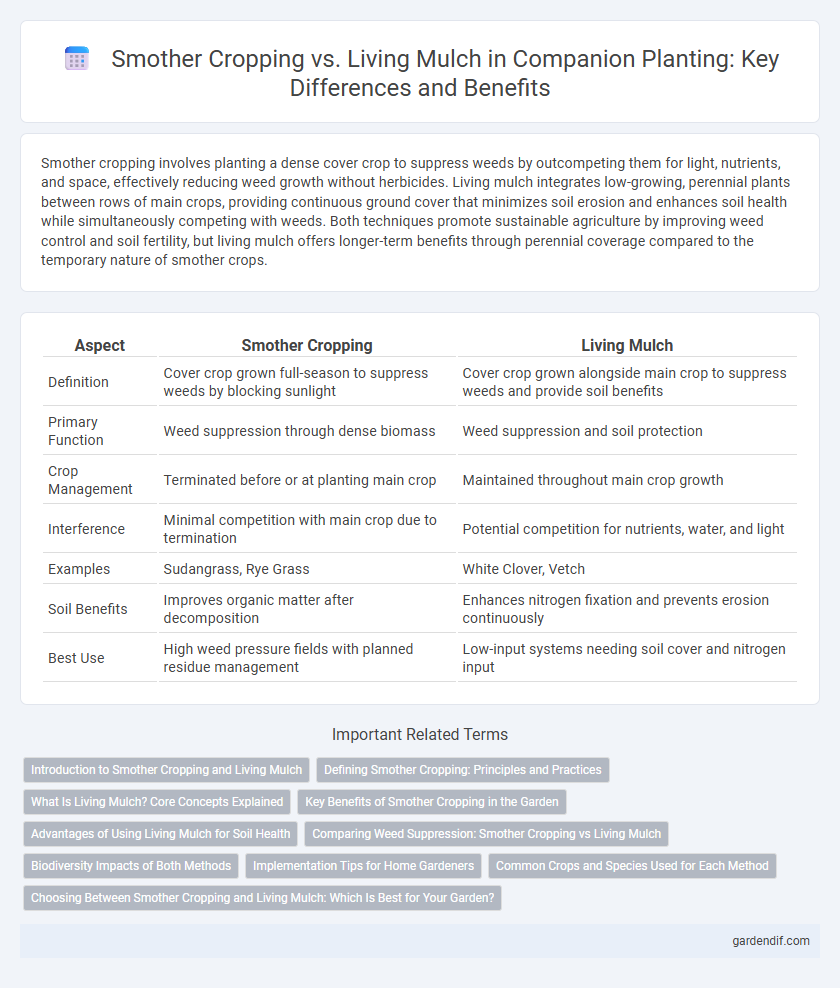
Smother Cropping vs Living Mulch Illustration
Smother cropping involves planting a dense cover crop to suppress weeds by outcompeting them for light, nutrients, and space, effectively reducing weed growth without herbicides. Living mulch integrates low-growing, perennial plants between rows of main crops, providing continuous ground cover that minimizes soil erosion and enhances soil health while simultaneously competing with weeds. Both techniques promote sustainable agriculture by improving weed control and soil fertility, but living mulch offers longer-term benefits through perennial coverage compared to the temporary nature of smother crops.
Table of Comparison
| Aspect | Smother Cropping | Living Mulch |
|---|---|---|
| Definition | Cover crop grown full-season to suppress weeds by blocking sunlight | Cover crop grown alongside main crop to suppress weeds and provide soil benefits |
| Primary Function | Weed suppression through dense biomass | Weed suppression and soil protection |
| Crop Management | Terminated before or at planting main crop | Maintained throughout main crop growth |
| Interference | Minimal competition with main crop due to termination | Potential competition for nutrients, water, and light |
| Examples | Sudangrass, Rye Grass | White Clover, Vetch |
| Soil Benefits | Improves organic matter after decomposition | Enhances nitrogen fixation and prevents erosion continuously |
| Best Use | High weed pressure fields with planned residue management | Low-input systems needing soil cover and nitrogen input |
Introduction to Smother Cropping and Living Mulch
Smother cropping involves planting fast-growing, dense crops specifically to suppress weeds and improve soil structure, often harvested before the main crop is planted. Living mulch consists of low-growing plants maintained alongside the main crop to reduce weed pressure, conserve moisture, and enhance biodiversity throughout the growing season. Both methods serve as sustainable weed management strategies, differing primarily in timing and crop integration.
Defining Smother Cropping: Principles and Practices
Smother cropping involves planting a dense, fast-growing crop primarily to suppress weeds and improve soil health by outcompeting undesirable plants for light, nutrients, and space. This practice enhances organic matter accumulation and reduces erosion, often using species like rye or buckwheat that establish quickly and can be easily terminated. Its principles focus on maximizing ground cover and biomass production without interfering significantly with the main crop's growth cycle.
What Is Living Mulch? Core Concepts Explained
Living mulch refers to a cover crop grown simultaneously with the main crop to enhance soil health, suppress weeds, and improve biodiversity. Unlike smother cropping, which relies on dense planting of a single species to outcompete weeds, living mulch involves intercropping multiple species that coexist with the primary crop. This practice optimizes nutrient cycling and moisture retention, fostering a sustainable companion planting system.
Key Benefits of Smother Cropping in the Garden
Smother cropping effectively suppresses weed growth by creating dense ground cover that outcompetes unwanted plants for sunlight and nutrients. This method improves soil moisture retention and reduces erosion by maintaining continuous soil coverage. Enhanced soil fertility through organic matter decomposition and nutrient cycling makes smother cropping a valuable strategy for sustainable garden management.
Advantages of Using Living Mulch for Soil Health
Living mulch enhances soil health by providing continuous ground cover, reducing erosion, and increasing organic matter through root biomass and leaf litter. It promotes beneficial microbial activity and improves soil structure by maintaining moisture and nutrient cycling. This method also minimizes weed pressure without disturbing soil, fostering a more resilient and fertile growing environment compared to smother cropping.
Comparing Weed Suppression: Smother Cropping vs Living Mulch
Smother cropping provides aggressive weed suppression by using fast-growing cover crops that outcompete weeds for light, nutrients, and space, effectively reducing weed germination and growth. Living mulch involves growing a low-growing crop alongside the main crop, maintaining ground cover to limit weed emergence while allowing resource sharing between plants. Smother cropping tends to deliver more immediate and intensive weed control, whereas living mulch offers sustained weed suppression with enhanced soil health benefits over time.
Biodiversity Impacts of Both Methods
Smother cropping significantly enhances biodiversity by suppressing weeds through dense cover crops that provide habitat for beneficial insects and soil organisms. Living mulch maintains soil cover year-round, promoting microbial diversity and supporting pollinators while minimizing soil erosion. Both methods enrich ecosystem complexity but smother cropping often leads to greater weed control, whereas living mulch better preserves soil health and long-term biodiversity.
Implementation Tips for Home Gardeners
Smother cropping involves planting dense cover crops like buckwheat or rye to suppress weeds and improve soil health, requiring careful timing to avoid competition with main crops. Living mulch uses low-growing plants such as clover or thyme interspersed with garden plants, needing regular monitoring to prevent nutrient competition and maintain soil moisture. Home gardeners should select cover crops compatible with their primary plants, consider local climate conditions, and manage growth to optimize benefits for pest control and soil fertility.
Common Crops and Species Used for Each Method
Smother cropping often utilizes fast-growing cover crops such as rye, buckwheat, and hairy vetch to suppress weeds and improve soil fertility, commonly paired with staple crops like corn or soybeans. Living mulch typically incorporates perennial species like white clover, crimson clover, and fescue alongside main crops such as fruit trees, vegetables, and grapevines to provide continuous ground cover and reduce soil erosion. Each method selects species based on compatibility with the primary crop and desired ecological benefits, enhancing overall crop health and yield.
Choosing Between Smother Cropping and Living Mulch: Which Is Best for Your Garden?
Choosing between smother cropping and living mulch depends on your garden's specific needs such as soil health, weed suppression, and crop compatibility. Smother cropping uses fast-growing plants to outcompete weeds and improve organic matter, while living mulch involves growing low-growing plants alongside crops to protect soil moisture and enhance biodiversity. Evaluate factors like climate, crop type, and maintenance capacity to determine the most effective method for sustainable garden management.
Smother Cropping vs Living Mulch Infographic

 gardendif.com
gardendif.com